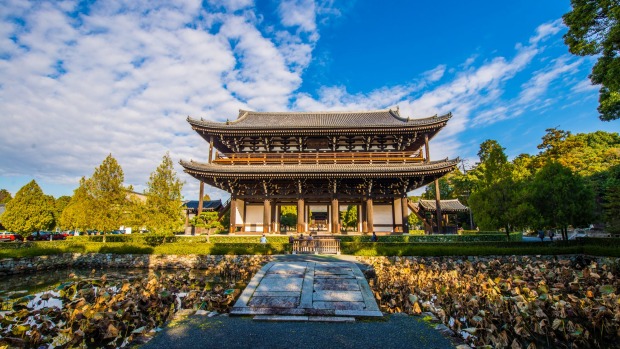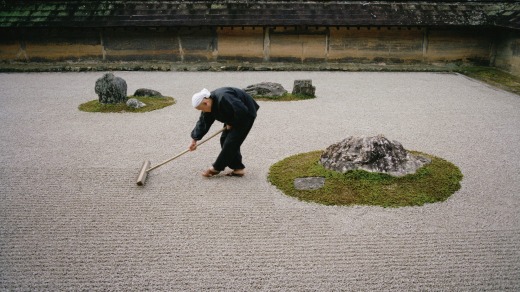
Kyoto's most famous Zen garden is Ryoan-ji. Its raked gravel and 15 carefully placed stones make it the world's most recognisable garden image. I love Ryoan-ji, which, despite the hoards of visitors adding their own snaps to the image load of the garden, still manages to instil a mood of mystery and quiet reflection.
It was made by an unnamed monk in the 15th century and was the template for a dry stone Zen garden for four centuries – until Mirei Shigemori brought the Zen garden into the 20th century and introduced it to modernism.
On a recent trip to Kyoto I was keen to see how Shigemori made this marriage work. Shigemori's original passion was not for the garden, but for other traditions in Japanese culture – painting and art history, calligraphy, tea ceremony and ikebana. The early decades of the 20th century were a tense time in Japanese culture as a modernising, westernising push clashed against a conservative desire to preserve Japanese traditions unchanged. Shigemori argued that Japanese culture was strong enough to survive engagement with the west and he tried to found a new arts school to pursue his modernising vision. Before he could get it going, though, the 1934 typhoon tore through western Japan, alerting him to the fragility of that other Japanese art – garden-making. He began surveying gardens all over the country, a project that culminated in the mighty 26-volume Illustrated Book on the History of the Japanese Garden.

Shigemori was now the country's expert on Japanese garden history and a year later, in 1939, he was given his first design brief – for the gardens around the hojo (abbot's residence) in the Tofuku-ji temple.
Tofuku-ji is a big complex of temples so famous for its maples that autumn crowds pack the pathways for momi-ji (maple viewing). The gardens aren't easy to find through the crowds, the buildings and sub-temples; the upside of that being that there are few other visitors. For Shigemori, creating modern gardens required following the approach of the old masters – combining knowledge and tradition with innovation.
Even knowing this, the grid garden at Tofuku-ji comes as a shock. Squares of clipped azaleas alternate with squares of raked gravel. The symmetry is not part of traditional Japanese garden design, yet here the grid references the patchwork of Japanese rice fields. The grid pattern is repeated in the next garden, but this time in moss and gravel, the grid gradually falling away into entropy.
Shigemori designed another set of gardens at Tofuku-ji, for the Ryogin-an sub-temple. The hojo here is the oldest existing one in Japan, its floor worn so silky you just have to sit and stroke it as you contemplate the garden. Dry stone Zen gardens, called kare-san-sui, are designed as an aid to meditation for monks in the Rinzai sect of Zen Buddhism. The patience, skill and concentration required to rake the specific pattern of the garden are part of Zen training and practice. An unwavering straight line is required in the Garden of Vanity, which is simply straight raked white gravel, edged in a straight line of river stones, backed by a bamboo fence and with a pavilion gazing onto the nothingness.
The emptiness of vanity is an easy message to read in this garden; the metaphor is a bit more obscure in one of the gardens in Zuiho-in, on the other side of the city. The feudal lord who dedicated this temple, Otomo, was convinced by Portuguese missionaries to convert to Catholicism. Not long afterwards, Christianity was outlawed in Japan. In one of the gardens around the temple an asymmetrical cross is abstractly marked in stones and points to a stone lantern, beneath which is buried a statue of the Virgin Mary.
The unseen statue is quite a powerful idea, but my favourite garden here is much more physical and energetic than this spiritual riddle. Stones in the form of a dragon leap from an ocean of waves of white gravel. The tines of the rakes used on the gravel form heaped ridges that add to the energy of the vertical rocks and the rising angle of the screening hedge at the back of the garden. It's invigorating and serene at the same time.
Shigemori designed domestic gardens as well as temple gardens, but the only one it's possible to visit is his own, now a "museum". You need to book as only a handful of visitors are allowed in to see the master's gardens and tearoom at any one time. There's no wandering allowed. Views of the garden are controlled and when the shoji screen slides back from the tea house facing into the garden, the view revealed is of perfectly placed rocks, moss, camellias and pines, with glimpses of the suburb through the trees: the traditions of the Japanese garden, set in modern life.
MORE INFORMATION
japantravelinfo.com
japanesegardens.jp
Major airlines offer flights to Kansai Airport, the closest major airport to Kyoto from Sydney and Melbourne. See qantas.com.au; jetstar.com; and jal.com. There are frequent fast train services to and from Kansai Airport to Kyoto Station.
Westin Miyako Hotel is near a subway station and is a short walk to the Philosopher's Walk and its temple gardens. Rooms start at 19,440 JPY.
See miyakohotels.ne.jp
You need to book a time to visit the Mirei Shigemori Garden Museum. Ask your concierge to book and to get instructions to hand to a taxi driver as it's hard to find.